Limpia is a free WordPress blog theme made for influencers and fashionistas. This responsive theme will make sure all your #ootds are presented with style.
Learn how you can get the most out of the theme with the Limpia WordPress theme documentation.
Limpia WordPress theme documentation, step 1: Theme specifications
- Post featured image recommended width is 1100px.
- Page and Post content maximum width is 760px.
- Recommended logo size is 280x60px.
Limpia WordPress theme documentation, step 2: Theme installation
The theme can be installed through the WordPress Admin panel.
- Log in to the WordPress Admin panel.
- Go to Appearance -> Themes.
- Click on the Add New button, at the top of the screen.
- In Add Themes screen, click on Upload Theme.
- Click on Choose theme, and then browse for a theme file on your computer.
- Click on Install Now to start the install process.
- After the installation is done, click on Activate theme.
A detailed video for theme installation is available here: https://help.themeskingdom.com/how-to-install-and-setup-the-theme.
After activating the theme, you will be prompted to install the required plugins. Required plugins in the Limpia WordPress theme documentation are:
Limpia WordPress theme documentation, step 3: Theme demo
To set the theme as presented in our demo, you can import the demo file.
Limpia WordPress theme documentation, step 4: Theme setup
Post Formats explained
Limpia theme has different post formats. Post formats are used to display posts in different ways, and with different effects on the homepage. To use all post formats, you will need to install and use the Classic Editor plugin.
Available formats:
- Standard
- Image
- Quote
- Link
- Video
Standard
Standard post format is a multipurpose post format. It can be used for anything. In this post format, the featured image will be displayed on the Posts page, and on the top of the single post page. On the Posts page, clicking on the featured image or the post title will open a single post page. Post excerpt will be displayed under the featured image on the Posts page.
Image
Image post format is a good choice when you want to focus site visitors’ attention on an image, rather than the text of a post. The featured image is displayed on the posts page, without the post excerpt. Clicking on the image will open the image in a lightbox effect while clicking on the title will open a single post page.
Quote
Quote is a post format used when you wish to present a quote, without any other content. Enter the text in the Quote Text field and author in the Quote Author field. Featured image is not used in this post format. On the Posts page, quote text and the author will be displayed, and there is no single post page when this post format is selected.
Link
Similar to the Quote post format, Link post format is a great choice when you need to insert a link to the specific location. Insert the link text into the Link Text field, and link the URL into the Link URL field. Featured image is not used, and on the Posts page, it is displayed as a link text.
Video
Finally, you can use the Video post format when you want to promote videos. You will need to enter the video URL from YouTube or Vimeo and to set the featured images. A featured image is displayed on the Posts page, and clicking on the featured image will open thevideo in Lightbox. Click on the title will open the single post page. The Post excerpt is displayed under the featured image on the posts page.
Theme setup
To set up the theme, please follow the next steps in the Limpia WordPress theme documentation:
- Go to Posts -> Categories and create categories that you will use to organize your posts.
- Go to Posts -> Add New and create several posts. Select the desired post formats, and set featured images for each post – in our demo, we used images in the different sizes and orientations. Associate the posts with the desired categories.
- Now, head to Pages -> Add New and create two new pages – About and Contact. The About page is used to display a short bio and image.
- Create another page – Contact. On the Contact page, you can display a short intro text and a contact form. Add a text block and insert your content. Add a form block, and Publish page. Make sure to install and activate the Jetpack plugin, otherwise, the Form block option will not be available.
- Time to set up navigation – go to Appearance -> Menus. Create New menu, and add pages to it. Mark that menu as a Primary. Create another menu – add links to your Social profiles, and mark that menu as Social menu.
- In Settings -> Reading set the theme to use Your latest posts reading settings.
- Almost done – in Appearance -> Customize you need to set Site Identity and Layout.
- In the Site Identity panel, either set the desired logo or enter Site Title and Tagline.
- Under Theme Settings – > Header Settings, check Enable sticky header.
- In Theme Settings -> Footer Copyright enter the desired copyright text in the Footer Text field.
Limpia WordPress theme documentation, step 5: The Customizer
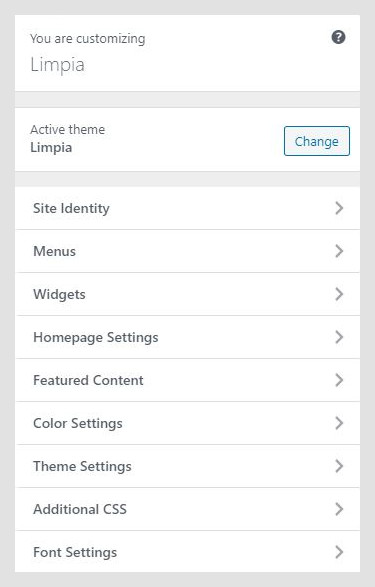
The Customizer allows you to modify theme visuals and settings quickly. Here are the customization options in the Limpia theme:
- Site Identity
- Menus
- Widgets
- Homepage Settings
- Featured Content
- Color Settings
- Theme Settings
- Additional CSS
- Font Settings
Site Identity
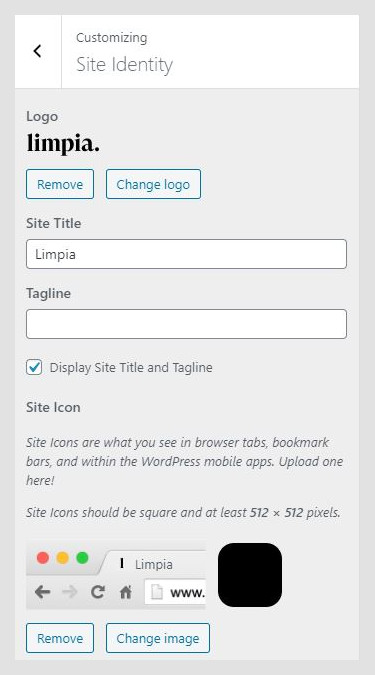
The Site Identity panel in the Limpia WordPress theme documentation is used for setting up basic site identity:
- Logo: Site Logo is an image in a .jpg, .jpeg or .png format. Suggested logo image size is 150 x 150px.
- Site Title: The name of your site. Ideal length should not exceed 20 characters. If the site title is longer, it will be displayed in two (or more) lines.
- Tagline: Tagline is a short description of the site, or simply a punchline of your business.
- Title and Tagline Visibility: If Display Site Title and Tagline is checked, both Site Title and Tagline will be displayed.
- Site Icon: Site Icon will be displayed in a browser tab, bookmarks or in the WordPress mobile app. The icon should be squarely-shaped, and the recommended icon size is 512 x 512px.
Menus
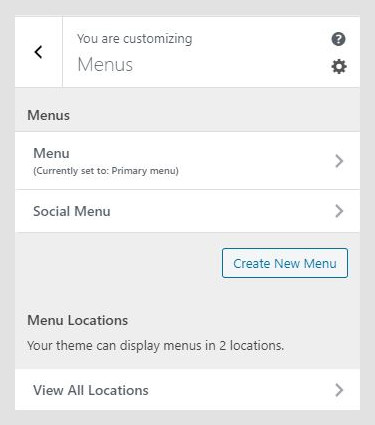
The Customizer menu option allows the user to manage available menu locations, and add and remove menu items. Limpia theme has two menu locations available – the Primary menu, which is mostly used as the main menu, and the Social menu. Menus can be managed from Appearance -> Menus as well.
Widgets
Widgets in the Limpia WordPress theme documentation are useful extensions for content, which you can add to your sidebar or other widget areas. In the Widgets option, in the Customizer, you can see available widgets area in the currently active theme.
Limpia theme has only the right-hand side widget area, which is available only on a single post page or on static pages. In our demo, we didn’t set widgets. Widgets can also be managed from Appearance -> Widgets. Widgets’ appearance can be controlled with the Widget Visibility feature.
Homepage Settings
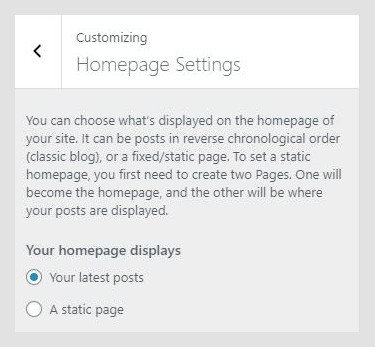
Homepage Settings work the same way Reading settings in Settings -> Reading does. Homepage settings allow you to set the theme to use static homepage, or to display the latest posts.
Featured Content

Featured Content is used to display desired posts that are tagged with the same tag. Featured content is displayed as a slider on the posts landing page. Options that are available for Featured Content:
- Tag Name: Enter the desired tag, so all posts tagged with the same tag will be displayed in the featured content.
- Do not display tag in post details and tag clouds: If this is checked, the tag that is used for featured content will not be displayed with other metadata.
- Also, display the tagged posts outside the Featured Content area: If enabled, posts will be displayed both in the featured content slider and in posts list.
How to setup featured content
- Go to Posts -> Add New and create several new posts. Be sure to set a featured image for each post, and tag them with the same tag e.g. “featured”.
- In Settings -> Reading make sure that the theme is set to use Your latest post reading settings.
- Go to Appearance -> Customize and in the Featued content enter the tag used for the posts that you wish to appear in the slider.
Theme Settings
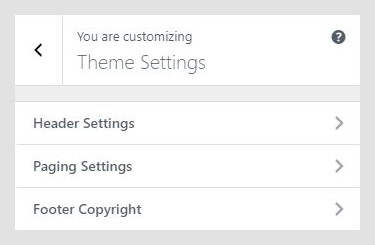
The Theme Settings panel in the Limpia WordPress theme documentation contains theme-specific settings.
- Header Settings
- Paging Settings
- Footer Copyright
Header Settings
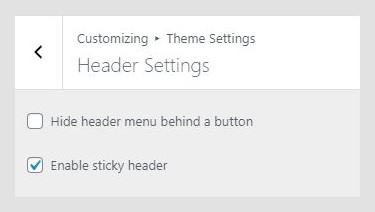
Header Settings allow you to control header behavior.
- Hide header menu behind a button: If checked, the menu will be displayed as a mobile menu.
- Enable sticky header: If enabled, the menu will always stay on the top of the page, instead of scrolling naturally with the page.
Paging Settings
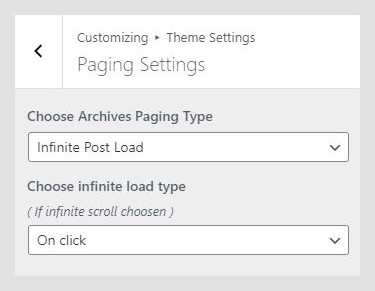
In the Paging Settings in the Limpia WordPress theme documentation, you can set how theme pagination works.
- Choose Archives Paging Type: Select pagination type – there are two types of pagination – classic and infinite scroll.
- Choose infinite load type: If the infinite scroll is selected, choose how infinite scroll will work – as the user scrolls or on button click.
Footer Settings

Footer Copyright Text: Text that will be displayed in the footer, as footer credits. You can enter basic HTML elements to create links and stylize footer text.
Color Settings

Setting up colors and adding a personal touch to the theme is important for building a personal brand. The Color Settings panel allows you to set colors for various elements in the theme.
Available settings:
- General Theme Colors: Colors used for the most common element like headings, paragraphs, links…
- Header Colors: Bunch of colors used for header background, main navigation links, textual logo…
- Portfolio Slider Colors: Color for portfolio slider elements – arrows and hover over arrows.
- Footer Colors: Color used for footer links.
Font Settings
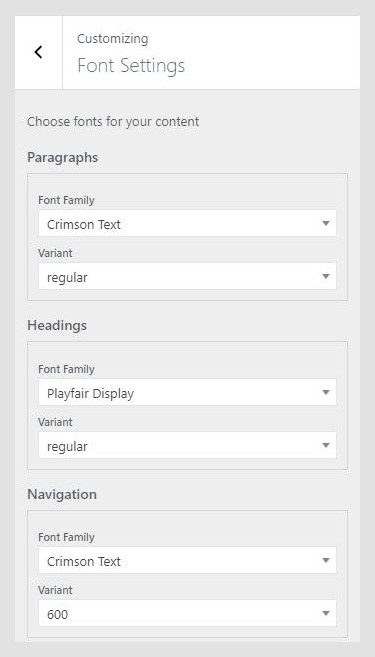
The Font Settings panel in the Limpia WordPress theme documentation is displayed only if the Kirki Framework plugin is installed and activated. Font Settings are used to set font families and weights for global text elements 一 content, headings, and navigation. Available fonts are from Google Fonts but without the extended variants. If you need assistance on how to integrate additional variants, please submit a support ticket.
